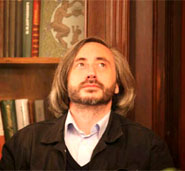|
 On August 19, the presentation of the book of verse of the famous poet, historian and publicist Andzhey Ikonnikov-Galitskiy from Sankt-Peterburg, “The Road to Mongun-Taiga”, will take place at the National Museum of Tuva. On August 19, the presentation of the book of verse of the famous poet, historian and publicist Andzhey Ikonnikov-Galitskiy from Sankt-Peterburg, “The Road to Mongun-Taiga”, will take place at the National Museum of Tuva.
The book was published by the Petersburg publishing house “Baltiiskie sezony” in 2009. On June 1, the initial presentation took place in Sankt-Peterburg, at the Vladimir Nabokov Museum. The publication is illustrated by works of the Tuyvan artist Valeriy Yelizarov, from his series “Liniya”.
Tuvan motifs are widely represented in the themes of the poems, associated with the author’s travels and archeological expeditions in which he participated.
In an interview in the magazine “Center of Asia”, the poet shared his impressions from his Tuvan travels, where he has been coming every summer since 1990.
“The most vivid memories are from my two trips to Mongun-taiga. When you get to the ridge where the view of the lake Khindiktig-Khol opens up, all your understanding, pre-conceptions and ideas about what is small and what is large in the world change.
It is comparable to the other strong impression of my life – in Constantinople, the dome of St. Sophia of Constantinople.
You walk under it, and all your orienting points and frame of reference, all your perceptions about large and small, necessary and unnecessary, majestic and paltry, change. Mongun-Taiga has the same effect.
– You fell in love with Mongun-Taiga of Tuva so much that you dedicated a whole collection of verse, “The Road to Mongun-Taiga”, which was published in Sankt-Peterburg this year. But could you tell us about that road in prose?
– Of course. In the summer of 2008, we were traveling over Mongun-Taiga to Altai, where our archeological expedition was working. There were four of us: Konstantin Chugunov, photographer Stas Shapiro, our driver and friend, Yuri Pishchikov and myself. We turned from Chadan to Khandagaity, beautiful taiga all around, larches, cedars. Then suddenly a snow-storm enveloped us – on June 7, on St.John the Baptist. After crossing the Khondergei pass we turned to the right – to Ovyur. And there is a completely different landscape. The taiga recedes, there is a sparse larch growth, mostly on the northern slopes. And then – Sagly valley with humongous dark green, almost smooth-appearing hillsides without forest. After that – the valleys of Arzaity and Barlyk, which are all beautiful each in its own way. And then - Mongun-Taiga mountains. It is a completely stunning landscape. Absolutely no people. Mountain tundra and alpine meadows. That time, we went by the road to Kyzyl-Khaya, right next to the state border. Seventy kilometers, and not a single yurt. We did not meet a single human being. Completely deserted landscape, which is beginning to look more and more lunar or Martian. And above that – the dome of Mongun-Taiga. Black slopes, white snow on top. And clouds floating above all that. Snow pouring out of them. From Kyzyl-Khaya, the road leads through a narrow defile now on one, now on the other bank of Mogen-Buren Then it comes out on a plateau. Again limitless space, rimmed by mountain ridges. Lakes, where birds nest. And then onto Buguzun Pass. It is a very difficult place – marshy mountain tundra, and huge boulders under the tundra vegetation. One can slip, or even wreck the car. Only the expert driving of Yuri Pishchikov saved us. The road, if you can call it a road, is very battered by vehicles – the locals from Kyzyl-Khaya drive to the stores in Altai in Kosh-Agach. Because there are no shops closer than that. One leaves in the morning, and in the evening, if everything works out, one comes home. And there were griffons, vultures, such huge birds that you could mistake them for sarlyks (Tuvan yaks).
|
|
